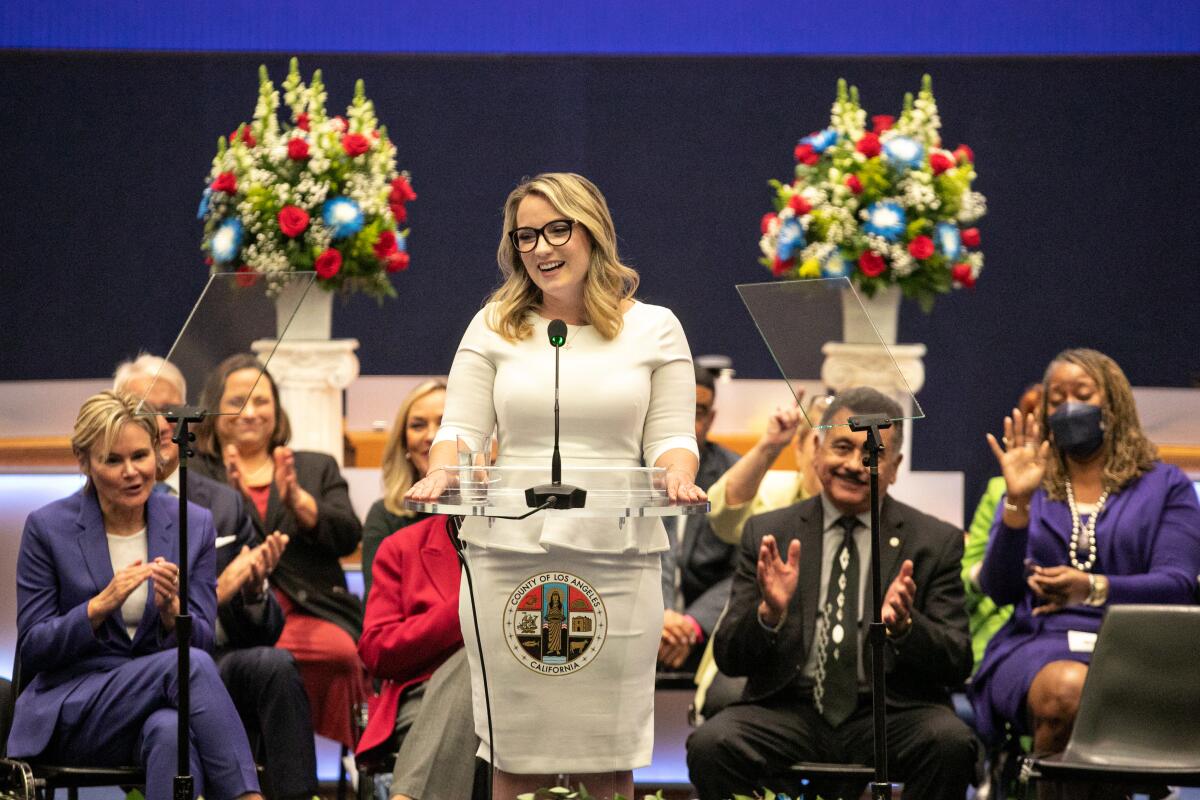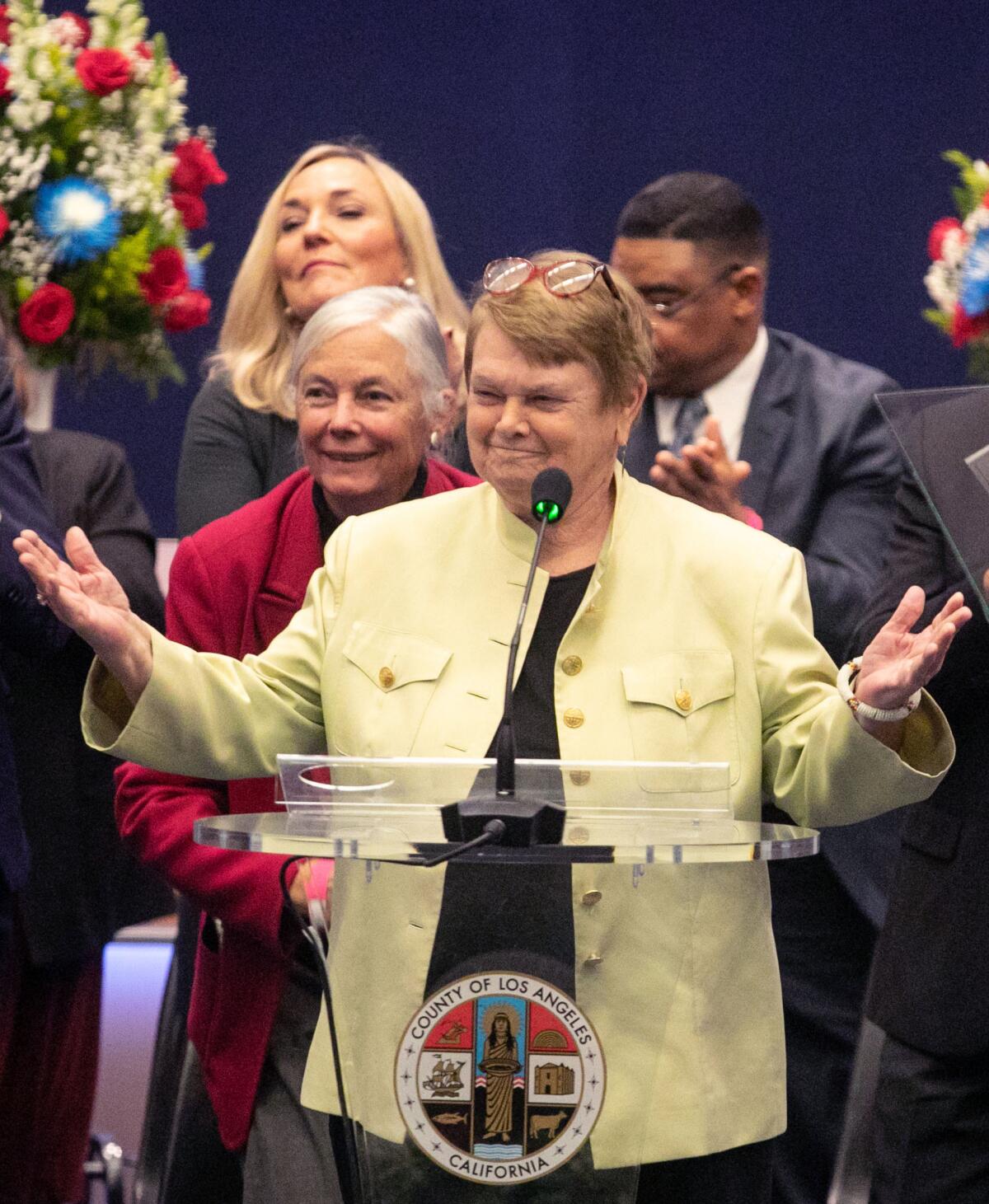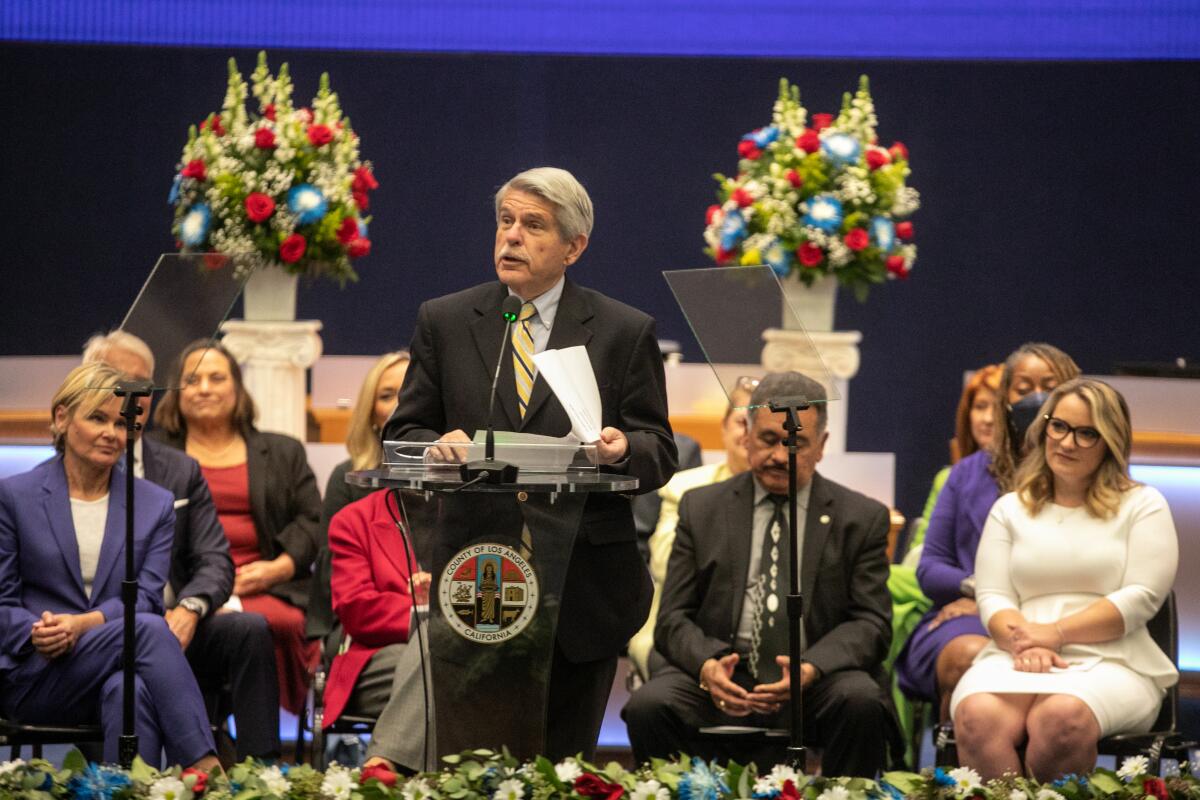Powerful and a little incognito: What it’s like to become an L.A. County ‘supe’

In the 76 seconds it took to recite an oath of office, Lindsey Horvath was transformed into one of the most powerful players in California politics. In fact, few positions in American municipal politics confer as much sweep as the one Horvath assumed Monday.
That’s what it means to become a Los Angeles County supervisor.
At 40 years old, Horvath is the youngest woman ever to step into the role. The former West Hollywood council member will represent the 3rd District, a 431-square-mile swath of Los Angeles County that includes parts of the San Fernando Valley. She goes from representing one of the smallest cities in the county — a population of about 35,000 spread over just 1.9 square miles — to a district representing nearly 2 million people.
That’s a jurisdiction with an economy larger than Argentina’s, a constituency larger than Austria’s and a budget larger than some U.S. states’.

Sheila Kuehl, the recently retired supervisor Horvath is replacing, said of the Board of Supervisors: “It’s kind of like five people being the governor of Ohio with no legislature.”
At her swearing-in ceremony, Horvath pledged to harness her newfound power to lift up the rent-burdened, student-debt-ridden younger residents of L.A. County.
“There will be those who doubt us — and question whether a millennial is ready to serve her county. But the median age of Los Angeles County is 38,” Horvath told the packed boardroom. “We know damn well that the world we’re inheriting won’t exist if we continue on the same path we’re on.”
One of five supervisors, she represents a district that stretches from coastal Malibu and Santa Monica to the San Fernando Valley. If District 3 were a city, it would be America’s fifth-most populated, coming in just under Houston.
In other words, it’s a position that comes with immense power. But it’s also a job that most outside the county government don’t fully grasp — even some of the people who have served on the once exclusively male board that earned the sobriquet “the five little kings.”

“I was here 20 years, and there’s some things that I couldn’t figure out,” said former Supervisor Zev Yaroslavsky of the “peculiar” bureaucracy he helped lead.
Yaroslavsky said the county is essentially run by a “five-headed executive.” As the newest of its heads, Horvath will have tremendous executive power, joining her colleagues in awarding contracts, hiring and firing department leaders, and crafting the county’s more than $40-billion budget, much of which comes from federal and state government funding. She will also have legislative power, with the ability to pass laws — as long as she has the support of at least two colleagues.
This unique form of government gives a county supervisor the power to not just come up with new legislation or initiatives, but actually see it across the finish line, she said.
“The power of the supervisors is more the power to get it done,” Kuehl said. “Get people into housing, get them off the street, get them mental health services — not just say they must have it.”
In terms of ability to make an impact, a sole county supervisor has far more to boast about than any elected official within Los Angeles city government, where political power is splintered among the City Council’s 15 members and the mayor. Yet, in terms of visibility, the county can at times seem more comparable to the one of the region’s seldom-heard-about special districts, which specialize in a specific service such as cemetery upkeep or mosquito extermination.
“People can tell you a lot about how the LAPD is going, how the mayor is doing, what’s happening with the City Council,” said Raphael Sonenshein, executive director of the Pat Brown Institute for Public Affairs at Cal State L.A. “When things go really bad with the City Council, as with the recording that was released, it’s not only local news, but national and international news.”
It takes a lot more for the Board of Supervisors to make international waves.
“When you become a county supervisor in L.A., you sometimes trade visibility for the power you get,” Sonenshein said.
Along with her four fellow supervisors, Horvath will be responsible for high-level oversight of dozens of departments and agencies, which together make up most of the region’s social safety net. Under the umbrella of L.A. County government is essentially every social service residents might need at any point in their lives, including mental health care, child welfare services, food assistance and aid for seniors. As such, the county deals most directly with the region’s poorest residents.
Horvath noted in her remarks that the board held “immense sway over our region’s health, justice and future” and promised to look out for the “ignored or marginalized” constituents of L.A. County.
Yaroslavsky, who made the same pivot as Horvath from a City Council member to a county supervisor, had similar goals when he arrived on the board two decades ago. But he said it was difficult at first to get word out to constituents on the county’s margins as to what exactly the little-understood government body was supposed to be doing for them.
“At the city, phones never stopped ringing off the hook. You know, potholes need to be fixed. The trees haven’t been trimmed. Light is out on Fairfax Avenue,” he said. “And, at the county, nope, nope. The phone didn’t ring.”
More to Read
Sign up for Essential California
The most important California stories and recommendations in your inbox every morning.
You may occasionally receive promotional content from the Los Angeles Times.











